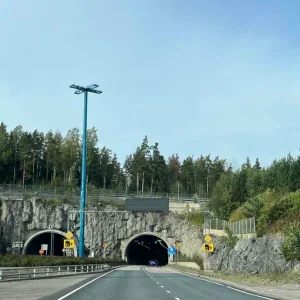Cleaning and minor repairs were needed in the world’s deepest subsea road tunnel – the Eiksund tube on the west coast of Norway – following the fatal crash and fire in late June, according to the Norwegian Public Roads Administration (NPRA, or Statens Vegvesen).
Five people were killed when two cars collided in the tunnel on the late Sunday evening of 28 June. One of the vehicles burned out but the fire damage to the tunnel was limited due to retardant in the structure and forced ventilation to clear smoke.
The police investigation is ongoing but NPRA, which handed its report to the authority, said that one of the cars was believed to have been travelling at approximately 190km/h, more than twice the speed limit which at that point is 80km/h.
NPRA plans to complete a detailed investigation of the accident over the coming three months.
The accident happened about 1.5km from the west portal of the almost 7.8km long tunnel, at a point where the vehicle with four passengers had travelled more than half the tube. The final stretch rises at almost 10% gradient and westbound traffic have two lanes, the descending eastbound traffic one lane.
NPRA was cleared to reopen the tunnel the following morning with a 50km/h speed restriction to enable repair work to be undertaken over the following weeks. The work in the still operational tunnel was completed late last month and while relatively minor the precise details were not immediately available.
Construction of the tunnel, half of which runs below the sea, started in 2004 and it came into service in February 2008. The west side of the vertical alignment is about 3km long with three lanes and an 87m2 section, and the east side has a gradient of 7.6% for 4.7km with two contraflow lanes and a 63m2 section.
The tube tunnel was built by local contractor Mesta, which completed the mostly drill and blast drive, which goes to a maximum depth of 287m, in early 2007 (T&TI, April 2007, p8).







